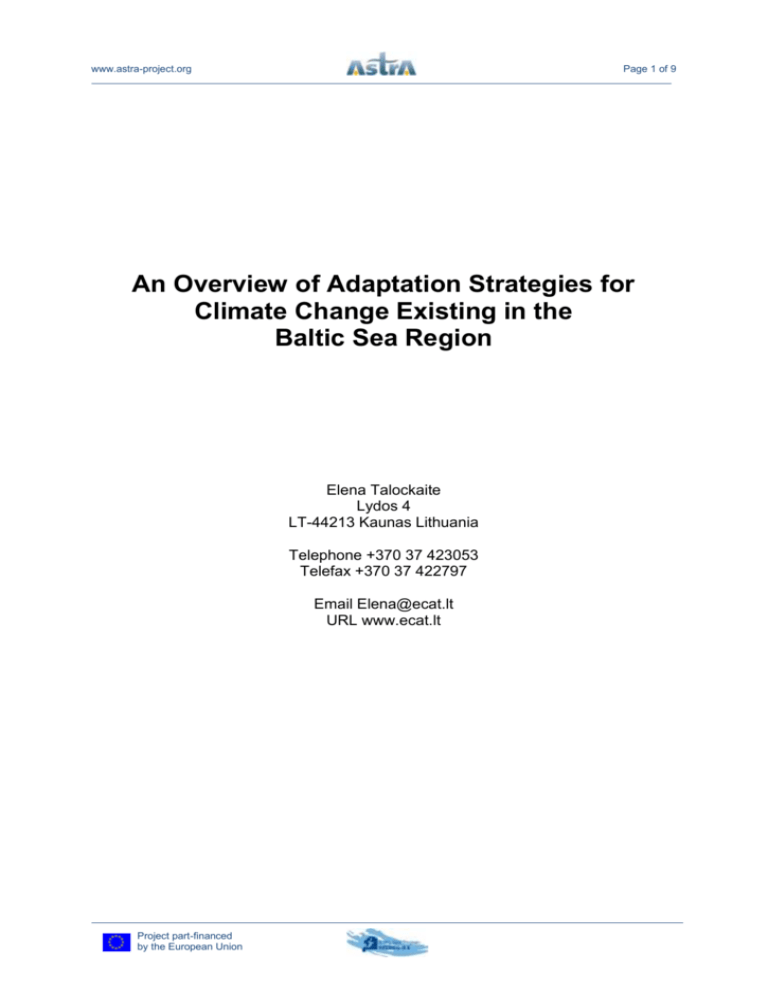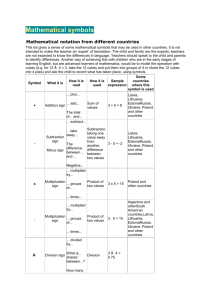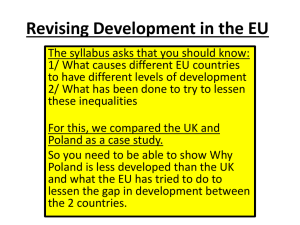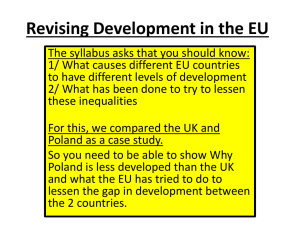Adaptation strategies_report_060515 - Astra
advertisement

www.astra-project.org Page 1 of 9 An Overview of Adaptation Strategies for Climate Change Existing in the Baltic Sea Region Elena Talockaite Lydos 4 LT-44213 Kaunas Lithuania Telephone +370 37 423053 Telefax +370 37 422797 Email Elena@ecat.lt URL www.ecat.lt Project part-financed by the European Union www.astra-project.org Page 2 of 9 Table of Contents 1. 2. 3. Introduction ........................................................................................................................ 3 Methodology ...................................................................................................................... 3 Overview of existing adaptation strategies ........................................................................ 4 3.1. Framework policies and cross-sectoral strategies ...................................................... 4 3.1.1. Integrated climate strategies ............................................................................... 4 3.1.2. Strategies of emission reduction ........................................................................ 5 3.1.3. Other framework documents .............................................................................. 5 3.2. Sector based documents ............................................................................................. 6 3.2.1. Building .............................................................................................................. 6 3.2.2. Energy ................................................................................................................ 6 3.2.3. Transport ............................................................................................................ 6 3.2.4. Industry............................................................................................................... 7 3.2.5. Health ................................................................................................................. 7 3.2.6. Water .................................................................................................................. 7 3.2.7. Forestry............................................................................................................... 7 3.2.8. Agriculture ......................................................................................................... 8 3.2.9. Other documents ................................................................................................ 8 3.3. Communication strategies .......................................................................................... 8 4. Strategies elaboration, adaptation and implementation ...................................................... 9 5. General conclusions ........................................................................................................... 9 Project part-financed by the European Union www.astra-project.org 1. Page 3 of 9 Introduction This report is produced in the frame of project „Developing Policies and Adaptation Strategies to Climate Change in the Baltic Sea Region“ (ASTRA) which is partfinanced by the European Union within the BSR Interreg IIIB Neighborhood Program. The project duration is from June 2005 till December 2007. The main objective of ASTRA project is to assess regional impacts of the ongoing global change in climate and to develop strategies and policies for climate change adaptation. More information about the project is available at project web-site (www.astra-project.org). The main goal of this document is to gather information about adaptation strategies existing in the Baltic Sea Region, to identify gaps and form a basis for the development of policy recommendations. 2. Methodology In order to gather information about adaptation strategies existing in the Baltic Sea Region two questionnaires have been developed and sent to project partners. First questionnaire aimed at gathering country level information, while second questionnaire gave a possibility to get the local or regional insight. Both questionnaires consisted of 3 sets of questions. In the first part project partners had to provide data on existing framework policies and cross-sectoral strategies (for example, existence of the integrated climate strategy, strategy on emission reduction, etc.). In the second part sector based approach was used. Main attention was paid on building, energy, transport, industry, health, water, forestry sectors and agriculture. Third part of the questionnaire aimed at the overview of communication strategies on climate change adaptation strategies in order to raise the awareness of various stakeholders groups. Country level information was gathered from Estonia, Finland, Germany, Latvia, Lithuania, Poland, and Sweden. Case study level information was gathered from Estonia, Germany, Finland, Lithuania and Poland (see Figure 1). Project part-financed by the European Union www.astra-project.org Page 4 of 9 Fig. 1. A map of the Baltic Sea Region indicating analyzed countries and case study areas 3. Overview of existing adaptation strategies 3.1. Framework policies and cross-sectoral strategies 3.1.1. Integrated climate strategies Five out of seven countries analyzed in this report have declared the existence of integrated climate strategy in their country. In most cases these strategies are connected with the implementation of Kyoto Protocol. For example, - National Climate Strategy (Finland, 2001, 2003, 2005); National Climate Protection Programme (Germany, 2005); Climate Change Mitigation Programme 2005-2010 (Latvia, 2005); National Strategy for Implementation of the United Nations Framework Convention on Climate Change (Lithuania, 1996); The Climatic policy of Poland – Greenhouse Gases Reduction Strategy by 2020 (Poland, 2003). Project part-financed by the European Union www.astra-project.org 3.1.2. Page 5 of 9 Strategies of emission reduction The variety of documents on emission reduction is bigger. In Estonia, for example, reduction of emissions is foreseen in the State Programme on the Reduction of Greenhouse Emissions 2003-2012, as well as State Distribution Plans of Greenhouse gas Certified Emission Loads 2005-2007. Finnish National Climate Strategy contains a programme of measures designed to meet Finland’s obligations under the Kyoto Protocol. Finland is obliged to bring its average annual greenhouse gas emissions down to their 1990 levels by 2008-2012. In Germany reduction of emissions is foreseen in CO2 Building Restoration Programme, Housing Space Modernisation, Ecological Construction, Greenhouse Gas Emission Trading Act, Renewable Energies Act, Biomass Regulation. Climate Change Mitigation Programme 2005-2010, Joint Implementation Strategy 2003-2012, as well as Concept on Participation in International Commission Trading are named among priority documents of Latvia where reduction of emissions aspect is emphasized. In Lithuania main emphasis on emission reduction is put in the Allocation and Trading Scheme of Greenhouse Gas Emission Allowances and The Strategic Branches of the Join Implementation Mechanism of the Kyoto Protocol of the UN Framework Convention on Climate Change. According to the Climatic Policy of Poland – Greenhouse Gases Reduction Strategy by 2020 Polish emissions of greenhouse gases have to be reduced by 40% in the year 2020 (in the year 2003 the reduction was 32%). 3.1.3. Other framework documents Among other framework policies and cross-sectoral strategies ASTRA project partners named following documents: - National Strategies on Sustainable Development (Estonia, Germany, Lithuania, Poland); National Environmental Policy / Strategy / Action Plan (Estonia, Lithuania, Poland); Long-term Economic Development Strategy or National Development Plan (Lithuania, Poland). Project partners also named specific documents, such as National Waste Management Plan (Lithuania, Poland), National Waste Disposal Programme (Estonia), National Strategy of Coastal Area Protection, Programme of Coastline Protection, Strategy on Production and Consumption Patterns Changing according to the Principles of Sustainable Development (Poland). Only Finland declares the existence of the National Strategy for Adaptation to Climate Change, which preparation started in 2003. This strategy describes the Project part-financed by the European Union www.astra-project.org Page 6 of 9 impacts of climate change in agriculture and food production, forestry, fisheries, reindeer husbandry, game management, water resources, biodiversity, industry, energy, traffic, land use and communities, building, health, tourism and recreation, as well as infrastructure. Following parts of the report will make an overview of sector based documents in other countries, mainly focusing on building, energy, transport, industry, health, water, forestry sectors and agriculture. 3.2. Sector based documents 3.2.1. Building National Development Programme till 2010 adopted in the year 2000, as well as Action Plan in the Field of Architecture 2004-2008 adopted in the year 2004 in Estonia can be considered as an example of sector document in the field of building. 3.2.2. Energy More documents exist in the Baltic Sea Region in energy sector. All these documents can be divided into three main categories: 1. Energy sector development plans and national energy strategies: e.g., Long-term (until 2015) Public Fuel and Energy Sector Development Plan, Electricity Sector Development Plan 2005-2015 (Estonia), Energy Policy in the Electricity Sector (Latvia), National Energy Strategy (Lithuania), Electricity Programme, Energy Policy until 2025 (Poland). 2. Strategies on renewable energy: e.g., Renewable Energy Act and Biomass Regulation (Germany), Proposal on Strategy on Renewable Energy Resources, Programme on Production and Use of Biofuel 2003-2010 (Latvia), Strategy on renewable energy development, Programme of Wind Energy Development (Poland). 3. Documents on energy efficiency: e.g., National Energy Efficiency Strategy (Latvia), Consumption Efficiency Increase Programme (Lithuania). 3.2.3. National Energy Transport Project partners declared following documents in transport sector: Transportation Development Plans 206-2013 (Estonia), Federal Transport Network Plan (Germany), Guidelines for Public Transportation Development in 2005-2014 (Latvia), Long-term (until 2025) Strategy of Transport System Development (Lithuania), Transport Policy 2006-2025 and Sectoral Operational Programme – Transport 2004-2006 (Poland). Project part-financed by the European Union www.astra-project.org 3.2.4. Page 7 of 9 Industry Industry sector related documents declared by project partners are quite different. For example, Industrial Development Guidelines 2004-2013 adopted in the year 2004 exist in Latvia. Poland declares the existence of National Environmental Monitoring Plan for 2006. While in Germany Federal Immission Protection Law updated in 2006 is named among main industry sector related documents. 3.2.5. Health There are not so many health sector related documents declared by project partners. Lithuanian National Environmental Health Action Programme 2003-2006 adopted in 2003 and Polish Act of Natural Disaster State adopted in 2002 were named among health sector related documents. 3.2.6. Water There is also a variety of water sector related documents starting with more general strategic documents, such as Water Management Strategy, which is currently under revision in Poland and ending with strategies related to different water categories or specific actions. For example, Action Plan for Better Management of Marine Environmental Protection 2005-2007 adopted in Estonia in the year 2005, Goundwater Use and Protection Strategy 2002-2010 (Lithuania, 2002), Program for Oder River 2006-2016 (Poland, 2001). There is also National Plan of Flood Protection currently under development in Poland. However, this document still doesn’t consider the climate change issue. This situation will change when Flood Directive will come into force, then National Plan of Flood Protection will be obliged to take effects of climate change into consideration in the long-term perspective. In Germany responsibility of water sector management belongs to the level of Federal States, therefore German partners did not declare the existence of water sector related documents on national level. 3.2.7. Forestry Forestry sector related documents could be divided into two main categories – general forestry plans, policies or programmes and documents aiming at the increase of forest cover. Among the documents under first categories project partners named, e.g., Forestry Sector Development Plan until 2010 (Estonia, 2002), National Forest Policy (Latvia, 1998; Poland, 1997), National Programme on Forest (Poland, 2005). While Forest Increase Programme 2003-2020 (Lithuania, 2003) and National Programme for the Augmentation of Forest Cover until 2020 (Poland, 2003) belong to the second category. Project part-financed by the European Union www.astra-project.org Page 8 of 9 3.2.8. Agriculture There are also two categories of agriculture related documents in the Baltic Sea Region. National Rural development Plan (Estonia, 2001), Sectoral Operational Programme – Restructuring and Modernisation of the Food sector and Rural Development (Poland, 2004), Plan of Rural Areas Development 2004-2006 (Poland, 2004) and Strategy of Development of Rural Areas and Agriculture for the years 2007-2013 with prognosis for 2020 (Poland, 2005) cover general strategic agriculture related documents. Second group of agriculture sector related documents aims at the implementation of principles of environmentally friendly agriculture, as well as production and use of alternative fuels. Among this type of documents project partners named Programme for Biological Agricultural Development for 2003-2006 (Latvia, 2004), Good Agricultural Practice protocol (Poland, 2002) and Programme on Promotion of production and Use of Biofuel for 2004-2010 (Lithuania, 2004). 3.2.9. Other documents Among other documents project partners declared National Programme on Biodiversity (Latvia, 2000), National Strategy on Ecological Education (Poland, 2000) and National Programme on Ecological Education (Poland, 2003). Three related research programmes were or are still under implementation in Lithuania: - Integrated influence of anthropogenic and environment changes on vegetation of forests and agrosystems (2003-2006); - Regularities and mechanisms of sensitivity, vulnerability, adaptations and microevolution of ecosystems and their components under conditions of global change and anthropogenic impact (2003-2006); - The influence of climate variation on recent physical geographical processes in Lithuania (1998-2000). 3.3. Communication strategies Existence of communication strategies on climate change adaptation strategies in order to raise the awareness of different stakeholders groups was declared by Germany, Latvia and Poland. Several institutes and authorities communicate climate change in Germany, e.g. Federal Environmental Agency, Council for Sustainable Development. In 2002-2004 German Energy Agency carried out campaign “Action Climate Protection”. In Latvia thematic seminars and meetings are organized by Climate and Renewable Energy Department under the Ministry of Environment. One of the most important documents on climate change communication in Poland is National Strategy on Ecological Education. The necessity to improve information and Project part-financed by the European Union www.astra-project.org Page 9 of 9 education system in the range of climate protection is also mentioned as one of the objectives of Ecological Policy and Climatic Policy of Poland. 4. Strategies elaboration, adaptation and implementation Most of the framework policies and cross-sectoral strategies are elaborated by national Ministries of Environment. However, in certain cases other institutions also participate in the elaboration process, e.g., Ministry of Economy (Lithuania and Poland), Maritime Institute in cooperation with Maritime Office (Poland). National Ministries of Economy, Culture, Communications, Agriculture, Transport, Finance, Regional Development and Local Governments, Foreign Affairs, Health, as well as different science and research institutions participate in the development and later in the implementation of the listed strategic documents. Overview of the adaptation strategies for climate change existing in the Baltic Sea Region showed that biggest part of the assessed documents were initiated and elaborated using top-down approach. Public consultations and participation was organized only in the cases when it was legally required. 5. General conclusions Assessment carried out in this report gave a possibility to gather information about adaptation strategies for climate change existing in the Baltic Sea Region. Only Finland declares the existence of the National Strategy for Adaptation to Climate Change, which preparation started in 2003. This strategy describes the impacts of climate change in agriculture and food production, forestry, fisheries, reindeer husbandry, game management, water resources, biodiversity, industry, energy, traffic, land use and communities, building, health, tourism and recreation, as well as infrastructure. Other countries have framework policies and cross-sectoral strategies, as well as sector-based documents. However, the level of integration of climate change issue in these documents is very limited and in some cases unclear. Therefore there is a need for a deeper content analysis of these documents in order to make more concrete conclusions about existing gaps. Biggest part of the assessed documents was initiated and elaborated using top-down approach. Public consultations and participation was organized only in the cases when it was legally required. Information of different stakeholders groups and their involvement in the development and implementation process has to become an essential element of the adaptation strategy to climate change. Assessment of the documents also showed that there is a number of different institutions and organizations participating in the development and implementation of the strategic documents in analysed countries. Therefore, it is essential to ensure coordination and cooperation between involved institutions. Project part-financed by the European Union








